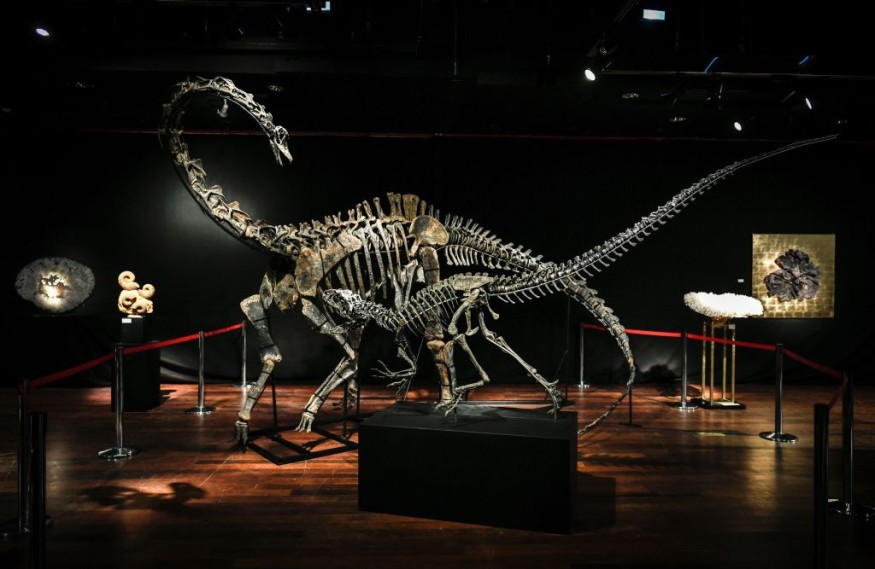
Sauropods are long-necked dinosaurs, including diplodocus, brachiosaurus, camarasaurus, and apatosaurus. They are four-legged herbivorous animals with a simple body plan that vary throughout the species. Although they walk on four legs like many animals today, a team of researchers found that these dinosaurs have gait unique to them.
An analysis of their fossilized footprints at the Lower Cretaceous De Queen Formation, Arkansas, showed that they have a "diagonal gait," wherein each of their front legs is in tandem with the hind leg at the opposite side. The study showed that conventional footprint analysis does not give a complete picture of how dinosaurs walked, so the team has to develop their own method.
The skeletons two Jurassic age (161-145 million years) dinosaurs, a Diplodocus (back) and an Allosaurus (front) are displayed on April 6, 2018, before being auctioned on April 11 at the Drouot auction house in Paris.
Gaits Used by Quadrupedal Animals
There has been a great deal of published work on gaits used by animals, particularly on their bone morphology, muscle structure, movements of joints, places of muscle attachment, and the physiology of muscle performance. Quadrupedal animals choose different gaits according to speed.
A gait is the pattern of movements on the animals' limbs, such as walking, trotting, cantering, and galloping. MailOnline has reported some types of gaits used by quadrupedal animals, which include the following:
- Diagonal gait - This is where an animal's every step of a front leg is in tandem with the hind leg on the opposite side. The hippopotamus is an example of an animal with this gait.
- Lateral gait - Previous studies showed that elephants walk by taking two steps on one side and two steps on the other. This is an example of a lateral gait type of walking.
- Pace gait - This is where the limbs of one side of the body, such as front right and hind right, move together at almost the same time rather than one after the other. An example of an animal that walks like this is the camel.
- Singlefoot gait - It is when the foot makes a sound when hitting the ground and creates a rhythm, wherein the time between each beat is the same. Horses can be trained to use different gaits, but untrained ones prefer singlefoot at normal walking speeds, although they trot at faster speeds and gallop at an even quicker pace.
Sauropods Have Diagonal Gait
Paleontologists assumed that these giant dinosaurs could have a similar gait as elephants, but a new method of footprint analysis showed that it was not the case.
"Everybody always assumed that sauropods walked like modern elephants," Dr. Jens Lallensack from Liverpool John Moores University told New Scientist. "But they didn't, and we think that's because the sauropods were just so much broader."
The team noted that given the large size of sauropods, it would have required them to have lots of energy to keep from toppling over if they have a lateral gait. In their new method of analyzing trackways from fossilized footprints, they accounted for variations in tracks and timing as the animal moves forward.
According to Phys.org, the team measured the distance between footprints of the three sauropods and noted whether it was by a front or hindfoot and whether it was left or right. Then they calculated how limb phases fit the track they measured to identify the animal's gait.
They also compared it to modern animals, such as elephants, and found that a front foot touched down on the ground first before a hindfoot from the opposite side was lifted. That means they did not wobble when walking and preserved their energy, suggesting that sauropods had a diagonal gait.
RELATED ARTICLE : Ancestors of Sauropod Dinosaurs Were Bipedal, Likely Quick to Move 205 Million Years Ago
Check out more news and information on Paleontology in Science Times.
© 2025 ScienceTimes.com All rights reserved. Do not reproduce without permission. The window to the world of Science Times.












